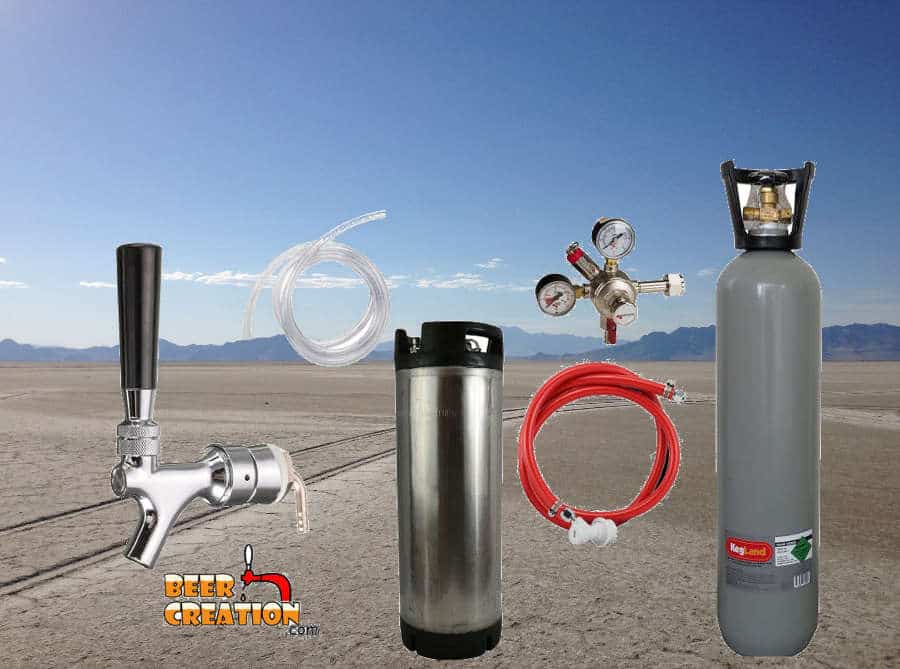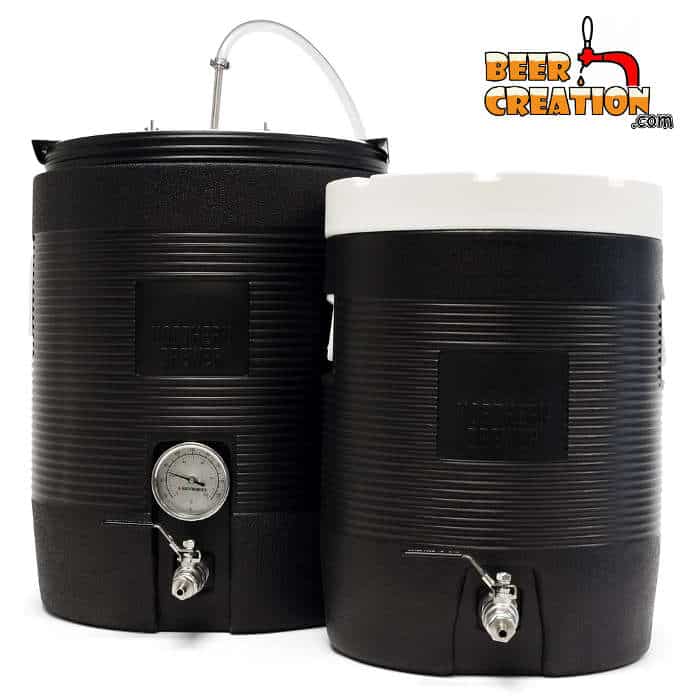Despite the vast spaces available on this wonderful planet of ours, we don’t all live in sparsely populated areas with acres of land to call our own. Personally, I live in a two-bedroom apartment in teeming Taipei, Taiwan. Space isn’t a commodity I have to play with but that hasn’t stopped me brewing beer.
Just like Parkinson’s law says that a task will take as much time as you have available to complete, the same can be said of brewing beer. But how small is too small and where are you going to put all that equipment when you aren’t brewing.
So how much space do you need for an average 5-gallon yield extract brewing kit?
To brew 5 gallons of beer you’ll need a pot with a volume of around 1.96 ft3 /55,665 cm3.A fermenter measuring 1.31 ft3 /37,320 cm3 in volume. For bottling, around 50 bottles taking up 1.14 ft3 /32,515 cm3 (total). Storing the pot, fermenter, bottles will need 4.43ft3 /125,500 cm3 as a rough guide.
So, in actual fact, you don’t need a lot of room to brew beer although where you make and store your beer may be in competition to other uses or members of your home.
In this article, I’m going to be speaking about basic brewing setups as well as touching on larger operations and exactly how much space you’ll need for each type of home brewery. (buy beer from local breweries)
Basic equipment needed

Firstly, let’s just go over some of the basic equipment which you cannot really brew without. I go into a lot more detail about this in another article, which you’re welcome to have a look at as well.
Equipment | Approx. Feet Squared | Approx. Meter Squared |
Brew Kettle | 1.96 | 0.05 |
Fermenter | 1.31 | 0.037 |
50x bottles | 1.14 | 0.032 |
Corny Keg | 1.56 | 0.022 |
Stockpot/ brew kettle
If you are following an average extract-based brewing kit, your target yield will be about 5 gallons of beer. For that, you need a pot that will hold between 6 and 10 gallons of liquid. In my example, I based it on my own 10-gallon (40l) kettle as I find it very effective for holding all the wort I need and also to minimize the impact of a boil-over. (1.96 ft3 /55,665 cm3 )
Fermenter/carboy
After you’ve boiled up beer and cooled it, you’ll need to place it into another vessel to ferment. As we are talking about 5 gallons of beer here, that’s not going to be a tiny container by any means. I based my estimate on a popular carboy fermenter from Northern Brewer, the Big Mouth Bubbler which you can see here on Amazon. ( 1.31 ft3 /37,320 cm3 )
Bottles
Bottling your beer and carbonating them with priming sugar is one of two methods to introduce carbon dioxide into your beer. Bottles take up a fair bit of space for the average 5-gallon batch, but their footprint really depends on how you store them. Stacking is an obvious floor saving method. But expect about the average refrigerator full in terms of space that needs to be earmarked for bottle conditioning. This is based on a standard 12 fl oz/ 330 ml bottle. (1.14 ft3 /32,515 cm3)
Keg
Kegging your beer and force carbonating it is another method which will take up slightly less space. However, you need to remember that in addition to the actual keg you need a cylinder of CO2 to pressurize it, so let’s just double the average estimate for the footprint of a keg. (0.78 ft3 /22,116 cm3 x2 = 1.56 ft3 /44,232cm3 )
Brewing Space
On brew day you’ll need as much space as you can get because you want to have everything you’ll need to hand. However, you can still get away with doing this is a fairly tight space if you get yourself organized.
Boiling your wort
As I’ve mentioned, I don’t live in a mansion by any means and I brew in a small kitchen on a regular basis (when my wife is out, of course!) In fact, the surface area I have to play with, including the stovetop which I use for smaller batches, is only 10.7 ft² / 0.63 m². If you’d like to know more about boiling wort on a conventional stove pot, then head over to my dedicated article on this topic.
Check out just how small the kitchen here in this video from my YouTube Channel where I bottled a 1-gallon batch in my kitchen:
In this space I managed to boil my wort, sometimes even lauter it when dealing with all-grain recipes and also rack it when bottling (a new keg is on my wishlist since my recent relocation).
How to increase your space when boiling?
If you are able to do it, then invest in a propane burner (see my recommended gear page for my choice) and boil outside. If you can source a dolly, or trolley or some sort to transfer your beer in and out of your home then it’ll make the process easier and you won’t have to suffer the heat of boiling a lot of liquid in your kitchen.
Personally, there’s quite a nice rooftop garden in my building as well as a communal square to the rear which I have my eye on. I just have to move the brew kettle more easily to venture outdoors.
Storage Space
There are two things to bear in mind when it comes to storage, the storage of your aging/carbonating beer as well as the storage of your equipment after use.
As I mentioned, you need between 1.14 ft3 /32,515 cm3 and 1.56 ft3 /44,232cm3 of space depending on if you are bottle conditioning or kegging your beer. If you have space, then you could consider investing in a kegerator which will allow you to store away your beer as it’s conditioned while not leaving it looking a mess.
Something like the Kegco K309SS-2 Kegerator (check the latest deals on Amazon) has a footprint of 3.90 ft2 /0.36 m2 and a total volume of 10.7 ft3/0.019 m3. This way you could not only control the temperature of your cooling wort but also your carbonating beer either in a keg or in the bottle.
Scaling up your home brewery
Of course, up until now, I’ve been talking about very basic brews of only 5 gallons using very basic equipment. What if you want to scale up your brewing yields? What if you are switching to all-grain recipes? What even if you just want to get some fancy equipment? How much space do you need for all this?
Boil Kettles from 5 gallons to 20 gallons
I’ve asked around the community and the most recommended boil kettles from the people I spoke with are the GasOne Home Brew Kettle Pot and the Northern Brewer Magapot. Each product comes with a different range incapacity, and therefore space needed to store and use them. You can check out all these models for yourself by clicking on the links provided which will take you over to Amazon for the best deals.
Product | Capacity | Dimensions | Volume |
8 gallons | 19.2 x 13 x 12.9 inches | 0.98 ft3 | |
10 gallons | 18 x 15 x 15 inches | 1.53 ft3 | |
16 gallons | 19 x 16 x 16 inches | 1.86 ft3 | |
8 gallons | 15 x 15 x 20 inches | 2.72 ft3 | |
10 gallons | 17 x 17 x 21 inches | 3.4 ft3 | |
15 gallons | 14 x 14 x 28 inches | 4.98 ft3 | |
20 gallons | 20 x 20 x 25 inches | 5.68 ft3 | |
30 gallons | 15 x 15 x 30 inches | 6.13 ft3 |
All-grain equipment and size
When it comes to all-grain brewing, you can seriously reduce the equipment you need and also the space in which to brew it by going down the BIAB route. Here you’ll do your mashing and boiling in the same vessel, so as long as your brew kettle is large enough to manage both the strike and sparge water requirements, you don’t need any additional equipment.
If you aren’t going to Brew In A Bag, then you will have to lauter your grains in order to extract all the fermentable sugars you can out of them. For more information on this process, why not check out my articles on “What is lautering?”.
Basically, it’s recommended that you use a mash tun along with a hot liquor tank to hold your heated sparge water, especially for fly sparging.
I recommend that you invest in a complete lautering kit, along with a sparge arm (see my article here), just to make things easier for you. The best one I have found and at the best price is also by Northern Brewer and is now available through Amazon at a really reasonable rate for the equipment that you get.
The hot liquor tank can actually sit inside the mash/lautering tun for storage, which reduces the entire footprint down to 0.35 ft3 with a total volume of 6.4 ft3





